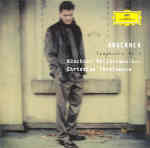First the good news: Christian Thielemann and the orchestra create a rousing climax at the end of the finale. Now the bad news: the prior 80 (out of 83) minutes show Thielemann to be quite clueless when it comes to Bruckner. Big surprise. Take the first movement. It basically operates in two tempos: adagio or allegro. Some conductors, such as Jochum or Furtwängler, play the music very freely, both within sections and in making transitions between them, but all great performances have one thing in common: they clearly define the difference between adagio and allegro, not just in terms of absolute speed, but also in terms of rhythm and phrasing. Tell that to Thielemann, whose inaugural concert with the Munich Philharmonic this release commemorates. His allegro is as dull and clunky as Bruckner’s most vociferous detractors claim. You can hear this very obviously at the opening of the development section, where the upward tutti arpeggios for full orchestra alternate with the movement’s principal theme in the winds, each in its respective tempo. For this passage only, Thielemann tries to make some kind of distinction. He has no choice. But as soon as the main section of the development bursts in, the music becomes slower, thicker, and muddier.
In fact, those 83 minutes make this one of the slowest performances on disc, not because of the Adagio, which Karajan, Solti, and Celibidache (of course) all take even slower than Thielemann’s reasonable 20 minutes. That means he’s unusually droopy everywhere else, and in this of all symphonies that’s not a good thing. His scherzo, for example, admittedly plods only slightly at the outset, but then totally self-destructs in the excruciatingly drawn-out central development section, its intertwining lines for horn, flute, and violins sounding painfully clumsy and approximate in phrasing when squeezed out at this tempo. Dance music this is not. It barely staggers into the reprise of the opening–but speed, as noted above, is only part of the problem. Thielemann is notably soft on rhythm. Attacks and releases sound mushy, particularly in the outer movements. Take the finale’s fugue theme as announced by the strings, which Thielemann actually de-accentuates despite Bruckner’s clear directive that the last three notes must always be played as emphatic downbeats.
Dynamics are also very casually observed. For example, the woodwind solos that open the Adagio are too loud, while the brass playing at the same movement’s final climax is paradoxically overbearing and ugly, yet lacking in impact. Another example: the solo clarinet at the opening of the finale makes almost no distinction between pianissimo and forte, surely at the conductor’s behest. Thielemann obviously loves big, fat brass sonorities, and the symphony’s many chorales (weighted toward the tuba) sound impressive at first, then monotonously similar thereafter, an undifferentiated mass of tone unrelated to its context. Consider the appearance of the central chorale in the finale: parenthetically slow, but hardly grand. Thielemann’s dynamic adjustments, which consist of spurious decrescendos at the end of each phrase, only add to the overall feeling of flaccidity. This music should resound; each statement should echo and reverberate over the timid answers from the other sections of the orchestra. Not here. The extended meal that Thielemann makes of the soft string codetta preceding the double-fugue only emphasizes how wrong his instincts are in Bruckner.
Whenever the music needs to flow onward, you can count on Thielemann to stop it dead in its tracks. He is constitutionally incapable of sustaining tension, especially through quiet passages. This includes much of the Adagio–both the long sequences in the middle of its second subject as well as the entire last five minutes of the movement–and never mind those extended, pianissimo fugal episodes in the finale. I could go on and talk about Thielemann’s inability to give the first movement’s second and third subjects sufficient rhythmic profile; his willingness to let balances go awry at various climaxes; the lack of necessary contrapuntal clarity; or the failure to capture any of the music’s drama or spirituality. What a pathetic non-event Thielemann makes of the theoretically violent and terrifying conclusion of the first movement’s development section! He is a veritable fount of unidiomatic, unconvincing, and unmusical ideas, bringing nothing positive to the equation at all. I have no doubt that this orchestra could play the symphony better on its own, without a conductor.
Given the excellence of the competition in this most uncompromising and interpretively challenging of Bruckner symphonies, I can’t imagine anyone other than the most die-hard Bruckner completists wanting to hear this drab souvenir. The (live) sonics and the playing are certainly good enough to make it clear that full responsibility for the performance’s many defects lies squarely with the conductor. Munich, he’s all yours, with my sincerest condolences.
































